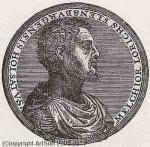Melchior Lorck
Melchior Lorck
Mjesto: Flensburg
Rođen: 1527
Smrt: 1564
Biografija:
Melchior Lorck (1526/27 – after 1583 in Copenhagen) was a renaissance painter, draughtsman, and printmaker of Danish-German origin. He produced the most thorough visual record of the life and customs of Turkey in the 16th century, to this day a unique source. He was also the first Danish artist of whom a substantial biography is reconstructable and a substantial body of artworks is attributable.
Melchior Lorck was born in either 1526 or 1527 as son of a city clerk, Thomas Lorck, in Flensburg in the duchy of Schleswig in present-day Germany. The first document relating to him is the receipt of a royal Danish 4 year travel stipend from the Danish king, Christian III, signed on March 22, 1549 in Flensburg. His earliest engravings stem from the years before the travel stipend, starting with rather unsecure copies after Heinrich Aldegrever, but soon developing a fine control of the burin as in the staunchly anti-papal The Pope as a Wild Man from 1545 and the Portrait of Martin Luther from 1548. With the royal travel stipend Lorck went to southern Germany, settling in Nuremberg around 1550, where he paid tribute to that city's preeminent artist of the previous generation, Albrecht Dürer in a portrait print building on Hans Schwarz' portrait medal of the artist.
After a visit in Rome in 1551 and what seems to have been a short period of employment at the residence of count palatine Otto Henry in Neuburg an der Donau he worked for the circle of the prominent Fugger family in Augsburg, thereby drawing nearer to the imperial Habsburg family.
In 1555 Lorck was assigned to the embassy that the German king Ferdinand I (from 1556 Holy Roman Emperor) sent to the so-called Sublime Porte, the court of Sultan Suleiman the Magnificent in Constantinople (Istanbul). The aim of the embassy was to negotiate a settlement over Hungary over which both parties claimed supremacy. After the Ottomans had defeated the Hungarian army in the Battle of Mohács in 1526, where King Louis II of Hungary died, the so-called Little War in Hungary, part of the Ottoman–Habsburg wars, had been raging, with the Ottomans holding the upper hand most of the time.
The embassy, which finally led to a cease-fire in 1562, was led by Ogier Ghiselin de Busbecq, is renowned for record of it found in the 'Turkish Letters' by Busbecq, published in 1581–1588 in Antwerp. Of the three and a half years that Lorck spent in the Turkish capital, approximately one and a half were spent with the rest of the entourage in confinement at the caravanserai where the Germans had been installed.
In 1555 at the caravanserai, the Elci Hani, Lorck produced engraved portraits of Busbecq and his co-envoys, Ferenc Zay and Antun Vrančić (Antonius Verantius), a few drawings of animals and a view over the rooftops of the city from one of the top windows of the lodging. In the periods of greater freedom however, he drew ancient and modern monuments of the city as well as the customs and dresses of the various peoples gathered from all parts of the Ottoman Empire. At the end of his sojourn, he must have been spending extensive time with the Turkish military, as he was later able to portray a large number of different ranks and nationalities in the Ottoman army.
Lorck returned to Western Europe in the autumn of 1559. In 1560 he is documented in Vienna, where he stayed until 1566. His drawings of antique monuments of Constantinople and surroundings date from these years. The Arcadius Column, the pedestal of Theodosius the Great's obelisk on the hippodrome and the pedestal of Constantine's Column both represent monuments that are lost today. The monumental Prospect of Constantinople, seen from across the Golden Horn at Galata / Pera was also made at this time. This drawing, 1145 centimeters long and 45 centimeters high, drawn on twenty-one sheets, executed in brown and black ink with some watercolor, teeming with detail, is considered to be one of the hallmarks of early topographic drawing. It also contains the earliest self-portrait of the artist. See the Constantinople Prospect in Leiden's University Library.
While in Vienna, Melchior Lorck was contacted both by the brother of the late king Christian III, duke Hans the Elder of Schleswig-Holstein-Haderslev who demanded his service. Lorck responded willingly, but was eager to excuse himself for being too busy. While finally answering the duke in January 1563, he also sent King Frederik II a letter, containing a lengthy description of his career up to the date. In 1562 Melchior Lorck had produced the large engraved bust portraits of Sultan Suleiman the Magnificent and the Persian envoy in Constantinople, Ismaïl, which he added to his letters. In the letters, Melchior Lorck asked for funding, which effected a gracious royal gift of 200 Danish rigsdaler, to be handed over to him via his brother, Andreas Lorck, who had himself recently stepped into the king's service in Copenhagen.
More...
Wikipedia link: Click Here



